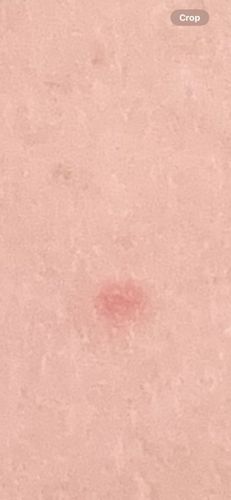Embedded Tick (possible larva or nymph)
Scientific Name: Ixodida (Order)
Order & Family: Order: Ixodida, Families: Ixodidae (hard ticks) or Argasidae (soft ticks)
Size: Unfed larvae are typically less than 1 mm; unfed nymphs are about 1-2 mm. The size increases significantly when engorged.

Natural Habitat
Grasslands, forests, wooded areas, brush, and areas frequented by wildlife and domestic animals (e.g., deer, rodents, pets).
Diet & Feeding
Obligate hematophagous (blood-feeding) ectoparasites. They feed on the blood of vertebrates, including mammals, birds, reptiles, and amphibians.
Behavior Patterns
Ticks typically quest (wait) on vegetation for a host to pass by. Once a host is detected, they crawl onto it and seek a suitable feeding site, often attaching in concealed areas of the body. They slowly feed over several days, becoming engorged with blood. The image shows a small, likely immature tick (larva or nymph) embedded in the skin and beginning to feed, indicated by the red, inflamed area around the bite site.
Risks & Benefits
Potential Risks: Ticks are significant vectors for a wide range of pathogens, including bacteria (e.g., Lyme disease, Anaplasmosis, Ehrlichiosis), viruses (e.g., Powassan virus), and protozoa (e.g., Babesiosis). Their bites can also cause local irritation, allergic reactions, and secondary infections. Benefits: Ticks generally offer no direct benefits to humans and are primarily known for their role as disease vectors. In ecosystems, they are part of the food chain for certain predators, but their overall ecological benefit is considered minimal compared to the disease risks they pose.
Identified on: 9/12/2025